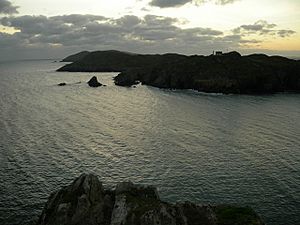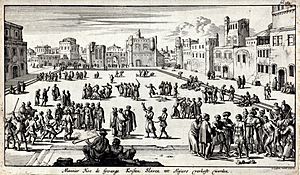Sack of Baltimore facts for kids

The sack of Baltimore was a surprise attack on a small village in Ireland. It happened on June 20, 1631. Pirates from North Africa, known as Barbary pirates, raided the village of Baltimore in West Cork, Ireland. These pirates came from places like Algeria and included Dutch and Ottoman Turkish people. This attack was the biggest slave raid ever on Ireland by these pirates.
The pirate leader was a Dutch captain named Jan Janszoon van Haarlem. He was also known as Murad Reis the Younger. He had been captured by Algerians but was freed after changing his religion. A man named Hackett, a fishing boat captain, helped Murad's group find the village. Hackett had been captured earlier and was promised freedom for his help. Later, Hackett was hanged from a cliff near the village for his part in the attack.
The Pirate Attack on Baltimore
Murad's crew included people from Europe who had changed their religion and Algerians. They launched their secret attack on the quiet village of Baltimore. This happened on June 20, 1631. They captured 107 villagers. Most were English settlers, but some local Irish people were also taken. Some reports say as many as 237 people were captured. The pirates focused on a part of the village still called the Cove today. The captured villagers were put in chains. They were then taken to Algiers in North Africa to live as slaves.
Life After the Raid

Some of the captured people became galley slaves. This meant they had to row large ships for many years. They might never set foot on land again. Others spent a long time working in homes or as laborers. Very few of them ever returned to Ireland. Only one person was bought back almost right away. Two others returned in 1646.
After the raid, the remaining villagers left Baltimore. They moved to a nearby town called Skibbereen. Baltimore was almost empty for many years after the attack.
Who Knew About the Attack?
In his book The Stolen Village, author Des Ekin wondered about the attack. He suggested that a powerful Catholic lawyer named Sir Walter Coppinger might have been involved. Coppinger was a major landowner in the area. He became the main owner after the death of Sir Thomas Crooke, 1st Baronet. Crooke had started the English settlement in Baltimore.
The O'Driscoll family, a local Irish clan, had rented Baltimore to the English settlers. This included the valuable fishing areas. The lease for the land was for 21 years. It was set to end on June 20, 1631. On that exact date, the land was supposed to go to Walter Coppinger because of a loan agreement.
Coppinger tried to get the settlers to leave Baltimore early. He wanted the valuable fishing rights sooner. After many legal arguments and problems, a court decided in 1630 that the settlers could stay. They had invested a lot of money in developing the town. Coppinger was told he had to rent the land to them forever.
Ekin suggests that Coppinger might have hired Murad Reis to raid Baltimore. This would make sure the land went back to him on June 20, 1631, as first agreed. Ekin admits there is no clear proof that Coppinger was involved. However, he points out that the raid happened on the exact day the land lease was supposed to end. This is a strange coincidence.
On the other hand, Murad might have planned the raid all by himself. It is known that officials had information that Murad planned to attack a port town in County Cork. They thought the target would be Kinsale, not Baltimore.
See also
- Sklavenkasse
- Slave raid of Suðuroy, raid on Faroe Islands in 1629
- Slavery in Africa
- Slavery in the Ottoman Empire
- Turkish Abductions, raid on Iceland in 1627

